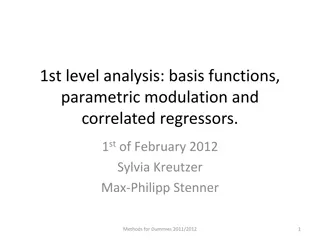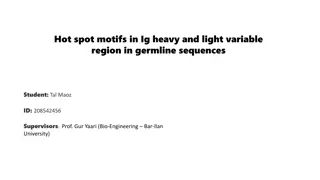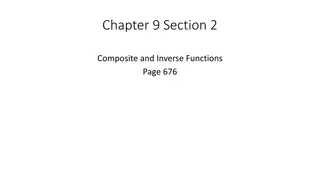Immunoglobulins and Their Functions
Immunoglobulins, also known as antibodies, play a crucial role in the immune response by recognizing and binding to specific antigens. The classes of immunoglobulins, such as IgA, IgG, IgM, IgE, and IgD, each serve unique functions in protecting the body against pathogens. These antibodies are produced by plasma cells and contribute to the body's defense mechanisms. Serological tests help identify different serotypes of microorganisms and detect antibodies present in serum. Complement fixation tests are immunological tests used to detect specific antibodies or antigens in a patient's serum.
Download Presentation

Please find below an Image/Link to download the presentation.
The content on the website is provided AS IS for your information and personal use only. It may not be sold, licensed, or shared on other websites without obtaining consent from the author.If you encounter any issues during the download, it is possible that the publisher has removed the file from their server.
You are allowed to download the files provided on this website for personal or commercial use, subject to the condition that they are used lawfully. All files are the property of their respective owners.
The content on the website is provided AS IS for your information and personal use only. It may not be sold, licensed, or shared on other websites without obtaining consent from the author.
E N D
Presentation Transcript
Immunoglobulins also known as antibodies, are glycoprotein molecules produced by plasma cells (white blood cells). They act as a critical part of the immune response by specifically recognizing and binding to particular antigens, such as bacteria or viruses, and aiding in their destruction.
Immunoglobulin classes 1-Immunoglobulin A (IgA)is an antibody that plays a crucial role in the immune function of mucous membranes. The amount association with mucosal membranes is greater than all other types of antibody combined. is the main immunoglobulin found including tears, saliva, sweat, colostrum and secretions from the genitourinary tract, gastrointestinal tract, prostate and respiratory epithelium. It is also found in small amounts in blood. of IgA produced in in mucous secretions,
2- Immunoglobulin G (IgG) is the main type of antibody found in blood and extracellular fluid, allowing it to control infection of body tissues. By binding many kinds of pathogens such asviruses, bacteria, and fungi. 3-Immunoglobulin M (IgM) is the largest antibody, and it is the first antibody to appear in the response to initial exposure toan antigen. In the case of humans and other mammals that have been studied, the spleen, responsible for antibody production reside, is the majorsiteof specific IgM production. where plasmablasts
4-Immunoglobulin E (IgE) parasitic worms, including Schistosoma mansoni, Trichinella spiralis, and Fasciola hepatica, Plasmodium falciparum. IgE may have evolved as a defense to protectagainstvenoms. IgE also has an essential role in type I hypersensitivity, which manifests in various allergic diseases, such as allergic asthma, most types of sinusitis, allergic rhinitis, food allergies, and specific types of chronic urticariaand atopicdermatitis.
5-Immunoglobulin D In B cells, the function of IgD is to signal the B cells to be activated. By being activated, B cells are ready to take part in the defense of the body as part of the immune system. Advantages of serological tests: 1-Determination of different serotypes of the microorganisms or their antigenic structures (bacterial ,parasitic ,protozoal and viral diseases) 2-detection on antibodies present in serum using an antigen antibody reaction.
The complement fixation test is an immunological medical test that can be used to detect the presence of either specific antibody or specific antigen in a patient's serum. Note ; Often non-specific Materials: 1. Wasserman's tubes. 2. Known standard antigen suspension. 3.Patient's serum (heated at 55 c for 30 minutes to destroy the complement). 4.Complement1 (fresh serum of guinea pigs). Procedure: 1.Mix the materials, and incubate in water bath at 37 c for 30 minutes. 2.Sensitized sheep erythrocytes 5% suspension (as indicator for the fixation of the complement). 3.Mix, and incubate in the water bath for 30-60 minutes, and read the result Positive: no hemolysis. Negative: hemolysis
Agglutination type of Tests Agglutination tests are based on the presence of agglutinating antibodies in patient sera that can react with specific antigens to form visible clumps. In the agglutination tests, the antibody - antigen reaction can be passive agglutination either a direct or reaction. Note antibodies (1) Rapid slide method It is a rapid qualitative test used for the rapid diagnosis and as field test for: A- Determination of the antigenic structure of bacteria: for typing different serotypes of Salmonella, E. coli, Pasteurella multocida, etc., ; visible aggregation of particles and
Materials: 1. Fat free glass slides. 2. Pure colonies of suspected strain. 3. Diagnostic antisera. 4. Sterile saline. Technique: 1. Make a suspension of the smooth colonies in saline on one end of the slide, and on the other end make a control from suspension only. 2. Add 2 drops of corresponding antisera to the suspension. 3. Read the result within one minute after continuous shaking. B- Whole blood agglutination test: for Identification of blood group and some poultry diseases. Materials: 1.Agglutination plate. 2.One drop of fresh blood. 3.Stained antigen. Result: 1.Clumping and agglutination within one minute is a positive result. 2.Suspension with regular turbidity is a negative result.
(2) Tube agglutination method "slow method" It is a quantitative test , It determined the level of Abs in serum ( end titer ),It is used for the diagnosis of typoid fever ,infections abortion , etc . Materials: 1. Seven agglutination tubes. 2.Sterile pipettes (1 ml and 10 ml). 3.Known standard antigen suspension. 4.Serum from diseased animal. 5.Normal or buffered sterile saline
Technique: 1.0.8 ml of phenol-saline is placed in the first tube and 0.5 ml in each succeeding tube. 2. 0.2 ml of serum under test in transferred to the first tube and mixed thoroughly with the phenol-saline already there. 3.0.5 ml of the mixture is carried over to the second tube from which, after mixing, 4.0.5 ml is transferred to the third tube, and so on 5.continue until the last tube from which, after mixing, 0.5 ml of the serum dilution is discarded. 6.This process of doubling dilutions results in 0.5ml of dilutions 1:5, 1:10, 1:20, and so on. 133 7.Add to each tube 0.5 ml of antigen at the recommended dilution and the contents of the tube are thoroughly mixed, thus giving final serum dilutions of 1:10. 1:20, etc. 8.The tubes are then incubated at 37 c for 20 hours 1 hours before the results are read. 9.The result are interpreted as follows
Precipitation Test: It is used when the antigen is in a colloid state (e.g. toxin or bacterial extract).It is very useful serological test for identifying antigenic substancesof all kinds. The main difference between these two reactions is the size of antigens. For precipitation, antigens are soluble molecules, and for agglutination, antigens are large, easily sedimented particles. ... If an agglutination reaction occurs, shown as clumping of the bacteria, the patient either had or has an S. typhi infection.
ELISA (enzyme-linked immunosorbent assay) Enzyme-linked immunosorbent assay (ELISA) is a method allowing the quantification of a desired marker in a biological sample. The marker can be an antibody, a hormone, a peptide, ora protein. Enzyme immunosorbentassay work ; is a plate-based assay technique designed for detecting and quantifying peptides, proteins, antibodies, and hormones. In ELISA, an antigen must be immobilized to a solid surface and then complexed with an antibody that is linked toan enzyme.
For general ELISA reference only. For ELISA/EIA kit-specific protocol questions, please refer to the kit instructions, or email techsupport@avivasysbio.com. 100 ul peptide (@4ug/ml) in coating buffer is added to individual wells of a microtiter plate. Incubate the plate for 2 hours at 37C or overnight at 4C. Remove the coating solution and wash the plate three times by filling the wells with 100 ul PBS-0.05%Tween20. The solutions or washes are removed by flicking the plate over a sink. The remaining drops are removed by patting the plate on a paper towel. Block the remaining protein-binding sites in the coated wells by adding 100ul blocking buffer, 3% skim milk in PBS per well. Incubate for 1 hour at RT with gentle shaking. 4. Wash the plate three times with 100ul PBS-0.05% Tween 20. Add 50 ul of diluted antibody to each well. Incubate the plate at 37C for an hour with gentle shaking. Wash the plate six times with 100ul PBS-0.05%Tween 20. Add 50ul of conjugated secondary antibody, diluted at the optimal concentration (according to the manufacturer) in blocking buffer immediately before use. Incubate at 37C for an hour. Wash the plate six times with 100ul PBS-0.05%Tween20. Prepare the substrate solution by mixing acetic acid, TMB and 0.03% H2O2 with the volume ratio of 4:1:5. Dispense 50ul of the substrate solution per well with a multichannel pipe. Incubate the plate at 37C in dark for 15-30mins. After sufficient color development, add 100ul of stop solution to the wells (if necessary). 1. 2. 3. 5. 6. 7. 8. 9. 10. 11.
There are different types of Elisa test: (1) Direct ELISA: This correlation can be used to extrapolate the concentration of antigen in an unknown sample from a standard curve. Direct ELISA is suitable for determining the amount of high molecular weight antigens.
2-Indirect ELISA Assay Indirect ELISA is a two-step binding process involving the use of a primary antibody and a labeled secondary antibody.























